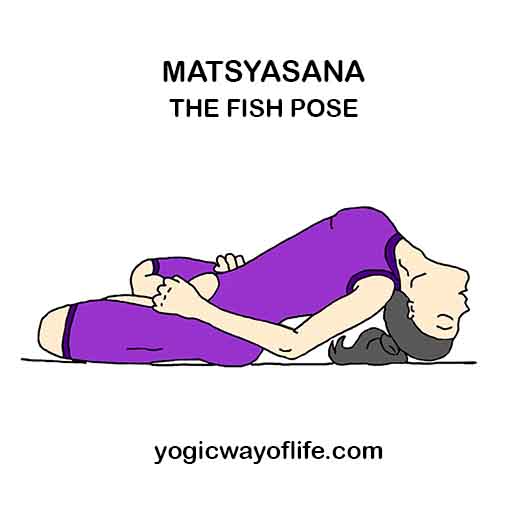Matsyasana or the fish Pose can be used to float on water in the final pose like a fish. In Sanskrit “matsya” means fish. Matsyasana is easy to perform and is used as a counter pose for many other yoga asanas. Matsyasana gives a good backward stretch to the neck and hence it is used as a counter pose for asanas that cause the forward bend of the neck. Matsyasana strengthens the back muscles.

How to do Matsyasana (The Fish Pose) ?
- Sit in Padmasana or the cross legged meditative pose.
- Slowly arch your back and continue till the head touches the ground.
- One can use the elbows to give support the weight of the trunk during the arching process.
- Once the back of the head touches the ground, bring your hands forward and grab the toes of the feet. The entire body weight will rest on the buttocks and the head and to some extend the elbows.
- Remain in this position for as long as it is comfortable.
- Relax and breathe normally and slowly in the final pose.
Benefits of Matsyasana (The Fish Pose)
- This asana is done as a counter pose to asanas like Halasana and Sarvangasana, where the neck is bent forward. It is usually performed after thses asanas. The duration is usually half or one-third of the previous forward neck bending asana. For example if you have done the Sarvangasana for 2 minutes, you may do this for up to 1 minute.
- Using this asana one can float on water. Please do not try this in a flowing river or sea lest you may get injured or get drowned. You may experiment this safely in a swimming pool, if you have someone to monitor you. With some practice you will be able to achieve this position in the water itself. You will find that the body sort of floats on water. The trick to this is to gulp a little air and fill your lungs so that floatation is achieved. With skill you will be able to keep the head and nose just above the water to breathe slowly. The rest of the body may be slightly submerged. You can float as long as you want with this technique.
- Matsyasana stretches and expands the chest and lungs. It is good for the entire respiratory system and relieves asthma and bronchitis.
- Matsyasana is good for relieving stiffness in the neck and shoulders.
- It improves digestion by stretching all the digestive organs.
- Matsyasana can relieve one of constipation.
Variation of Matsyasana (The Fish Pose)
For those who have difficulty in sitting in Padmasana, there is an easier variation of Matsyasana. In this variation one starts by lying on the back. Then bend the spine backwards to make an arch. The back of the head should touch the ground to support part of the weight. The legs will be straight. The elbows should rest on the side to support the weight of the trunk. The entire weight will rest on the buttocks, legs, elbows and the back of the head. Remain in the final pose for as much as you are comfortable. This is easier to perform and the benefits are similar to the main practice of Matsyasana.
